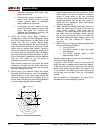
22 www.seektech.com Ridge Tool Company Elyria, Ohio U.S.A
SeekTech SR-60
Operating Tips for Passive Line Tracing
1. In Passive Locating if you are looking for a
known line, be sure you are using the best
frequency for the line in question. This may
be, for example, 60 Hz (1) for a power line, or
it may turn out that 60 Hz (9) produces a
more reliable response on a particular line.
2. If seeking a cathode-protected pipe in
Passive Mode, use higher-frequency (greater
than 4 kHz) to pick up harmonics.
3. Remember that pipes can carry currents that
will show up on a Passive Trace as well as
cables will; the only guarantee of a locate is
exposure and visual inspection.
4. In general, Passive Trace locating is less
reliable than Active Line Tracing because
Active Line Tracing offers the positive
identification of the signal from the
transmitter.
5. Especially in Passive Line Tracing, knowing
that you have found something is not the
same as knowing what you have found. It is
essential to use all the indicators available,
such as Measured Depth, Signal Strength,
etc., to confirm a locate. If it is possible to
access part of a passively-located cable, it
can then be energized using a transmitter and
positively traced.
6. While Passive Line Trace is most often used
on 50/60Hz power lines, other cables such as
phone lines, CATV lines, etc., can be
energized in operation, or by transient radio
frequencies in the region and may appear on
Passive Line Trace searches.
7. Verify a passive locate by finding a known
termination point and hooking up a transmitter
to it to do an active locate on the line, if this is
possible.
Sonde Locating
The SR-60 can be used to locate the signal of a
Sonde (transmitter) in a pipe, so that its location can
be identified above ground. Sondes can be placed at
a problem point in the pipe using a camera, push rod,
or cable. They can also be flushed down the pipe. A
Sonde is often used for locating non-conducting pipe
and conduit.
Important!
Signal strength is the key factor in determining
the Sonde’s location. Take care to maximize
the Signal Strength prior to marking an area for
excavation.
The following assumes that the Sonde is in a
horizontal pipe, the ground is approximately
level and the SR-60 is held with the antenna
mast vertical.
The field of a Sonde is different in form from the
circular field around a long conductor such as a pipe
or cable. It is a dipole field like the field around the
Earth, with a north Pole and a south Pole.
Figure 33: Earth's Dipole Field
In the Sonde’s field, the SR-60 will detect the points at
either end where the field lines curve down toward the
vertical, and it will mark these points on the map
display with a “Pole” icon (
). The SR-60 will also
show a line at 90 degrees to the Sonde, centered
between the Poles, known as the “Equator”, much like
the Equator on a map of the Earth if the planet were
viewed sideways (See
Figure 33).
Note that because of the SR-60’s Omnidirectional
antennas, the signal stays stable regardless of
orientation. This means the signal will increase
smoothly when approaching the Sonde, and decrease
smoothly moving away.
Note: A Pole is found where field lines turn vertical.
The Equator occurs when the field lines are
horizontal.


















